-
Car Reviews
- All reviews
- Midsize SUVs
- Small cars
- Utes
- Small SUVs
- Large SUVs
- Large cars
- Sports SUVs
- Sports cars
- Vans
Latest reviews
- Car News
-
Car Comparisons
Latest comparisons
- Chasing Deals
The first Cadillac to officially go on sale in Australia in decades also happens to be the first-ever electric Cadillac. But has the striking Lyriq been worth the wait?
It might surprise you to discover that Cadillac – the 123-year-old American luxury marque that has been the pinnacle of the General Motors stable since 1909 – has never actually officially been sold or marketed in Australia for six decades.
Cadillac almost made a return in 2008 with the gen-two CTS sedan, but the global financial crisis (and GM’s subsequent bankruptcy) put an end to that, with over 80 cars en route redirected to other right-hook markets. Which was a shame because the handsome CTS was an impressive car, offering essentially a BMW 5 Series package for a 3 Series price.
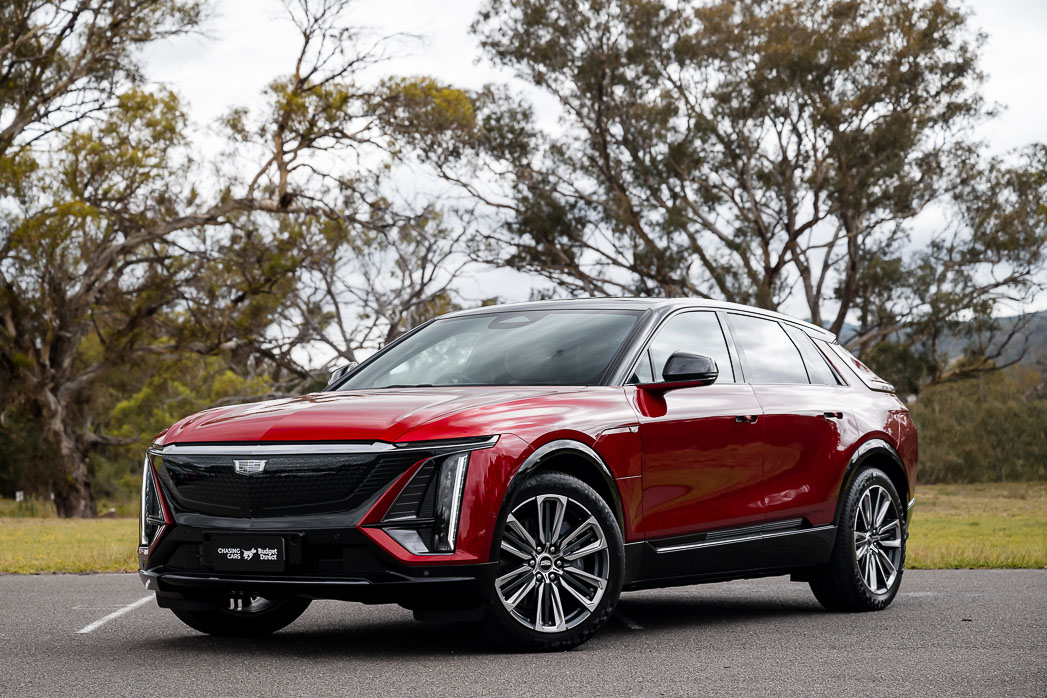
This time around, Cadillac is extending its reach upscale, certainly to begin with. Instead of a sub-$100K luxury sedan, Cadillac is debuting with its Lyriq electric crossover SUV – the first-ever electric Cadillac and now the first-ever Cadillac to be sold in Australia for generations.
On sale in the US since 2022, the Lyriq that Australia sees is produced in the same Spring Hill, Tennessee, plant as American models, but in right-hand-drive form – a factory configuration that also gets exported to the UK, Japan and New Zealand.
In Australia, the Lyriq starts at $117,000 (before on-road costs) for the Luxury model, and $2000 more for the Sport variant. And on paper, it offers plenty of metal for the money – in fine American tradition – given that its sharp-edged presence occupies almost five metres in length, underpinned by a vast 3094mm wheelbase.
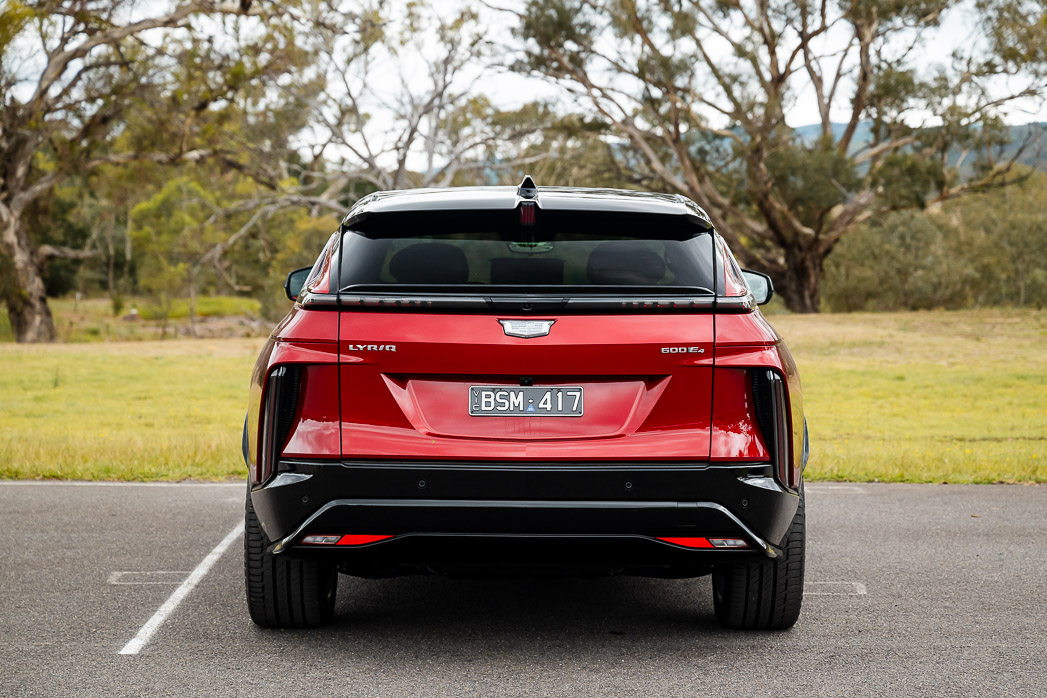
But does the Lyriq offer the seating comfort, ride comfort, refinement and quality of materials that the Cadillac brand was once renowned for – and will be mandatory if the Lyriq wants to succeed at establishing Cadillac as a genuine force among the luxury marques that populate Australia?
Cadillac Australia and New Zealand will be offering two all-electric Lyriq variants from launch – the Luxury ($117,000 before ORCs) and the Sport ($119,000 before ORCs).
We tested both variants – a Lyriq Sport with the following options: Radiant Red paint ($2535), black-painted roof ($1300), and Oxford Stone leather interior ($3900), taking its as-tested price to $126,735 before on-road costs. And a Lyriq Luxury (not shown) in gorgeous Emerald Lake metallic green with the standard Noir ‘Inteluxe’ faux-leather interior.
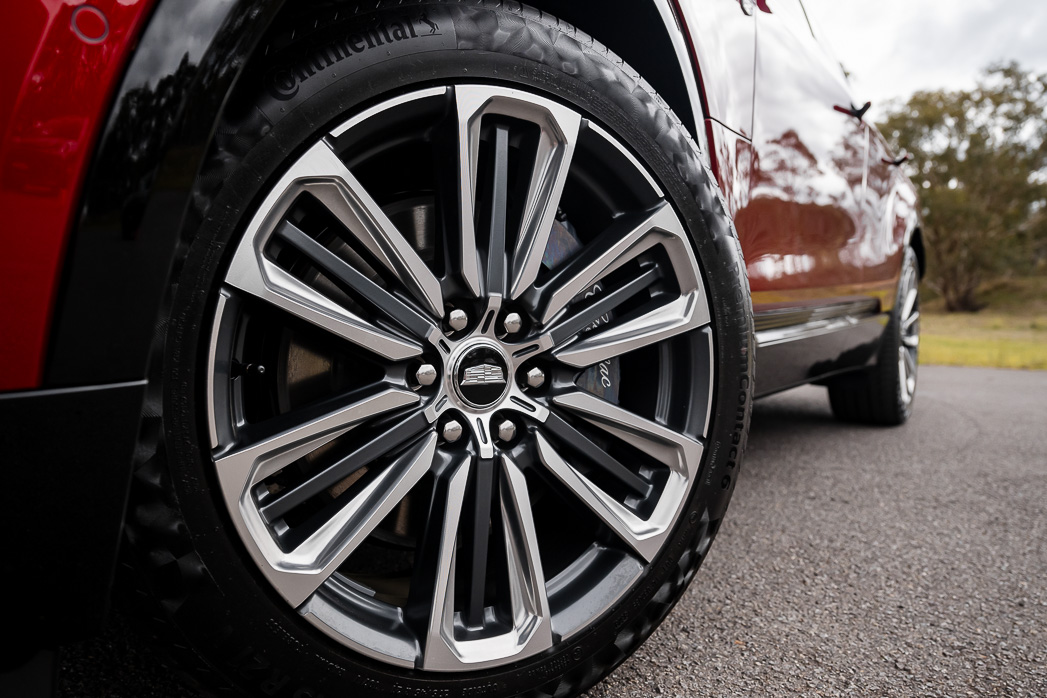
Nearest price competitors to the Lyriq Sport AWD include the Audi Q6 e-tron quattro ($122,500), BMW iX xDrive 45 ($142,900), Mercedes-Benz EQE 350 4Matic ($146,700) and Polestar 3 Long Range Dual Motor ($131,054).
Standard equipment on both Lyriq variants includes:
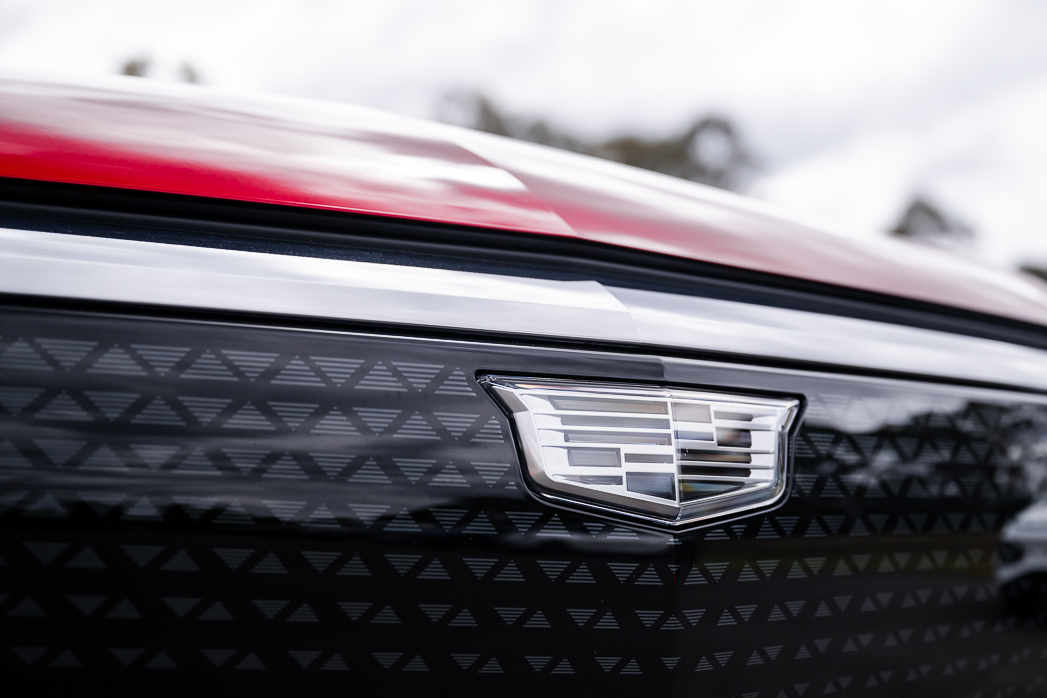
Cadillac’s US-built Lyriq offers six colours on the Luxury (silver, red, white, green, grey, black) and four on the Sport (silver, red, white, black) – with most able to be paired with a black roof.
The Lyriq is an intriguing car to drive. With GM’s 102kWh ‘Ultium’ battery embedded in its floor, a claimed weight distribution approaching 50/50, and broad track widths, the Lyriq offers a planted, four-square stance on the road that feels confidence-inspiring from behind the wheel.
It also feels genuinely solid – not just because the long five-door weighs 2.7 tonnes but also due to its vast 275/40R22 Michelin tyres. This is a big car with a big footprint. And yet unlike Cadillacs of old, the Lyriq doesn’t necessarily make driving effortless.
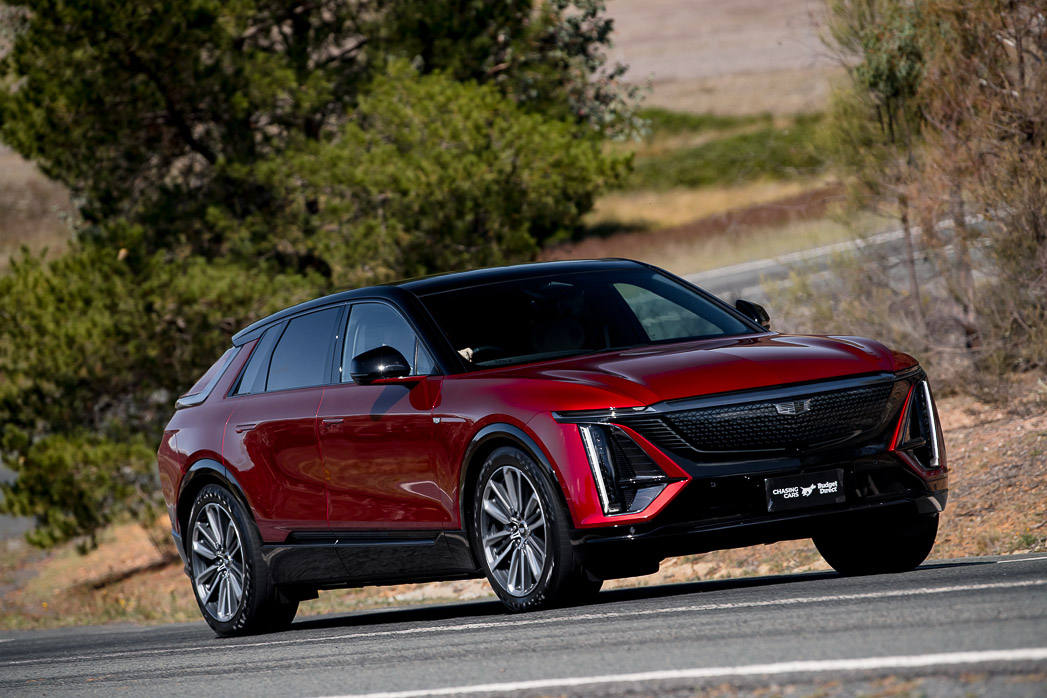
It offers two drive modes – Tour and Sport – which essentially alter the steering weighting, stability electronics and powertrain response given that the Lyriq doesn’t offer adaptive dampers, let alone the adaptive air suspension of many of its rivals.
Cadillac claims the Lyriq’s ‘Passive-Plus Premium Dampers’ are good enough not to warrant more sophisticated suspension hardware, but that isn’t really the way it plays out in real-world driving.
Firstly, the Lyriq’s steering weighting is too heavy in Sport mode, making the regular Tour setting superior for all situations. Still, it’s no solution because the steering-wheel spokes are too thick, its turning circle is a broad 12.1 metres, and the amount of wheel twirling required to point it into a corner (or any roundabout) makes it feel cumbersome.
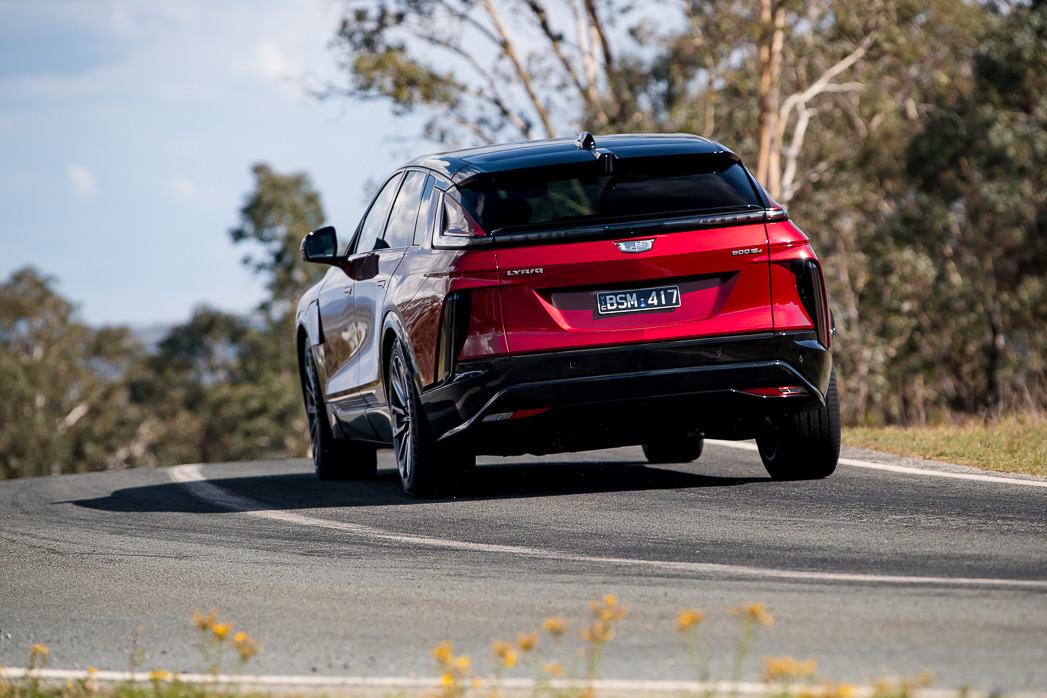
Once you learn just how much steering lock is required to guide the Lyriq’s front end, it feels quite balanced handling-wise. But this is a Cadillac that makes you work for any kind of dynamic enjoyment. Instead of making cornering effortless, it makes it a challenge – proving that this is yet another American car essentially best suited to freeways.
Driving in a straight line, you don’t notice the over-thickness of the wheel spokes or the near total lack of side bolstering in the front seats.
But you do notice the elastic excellence, urgent smoothness and exponential thrust of the Lyriq’s 388kW/610Nm powertrain, which is outstanding, as well as the steering numbness at dead-centre and the suspension thrumming away on the road surface beneath.
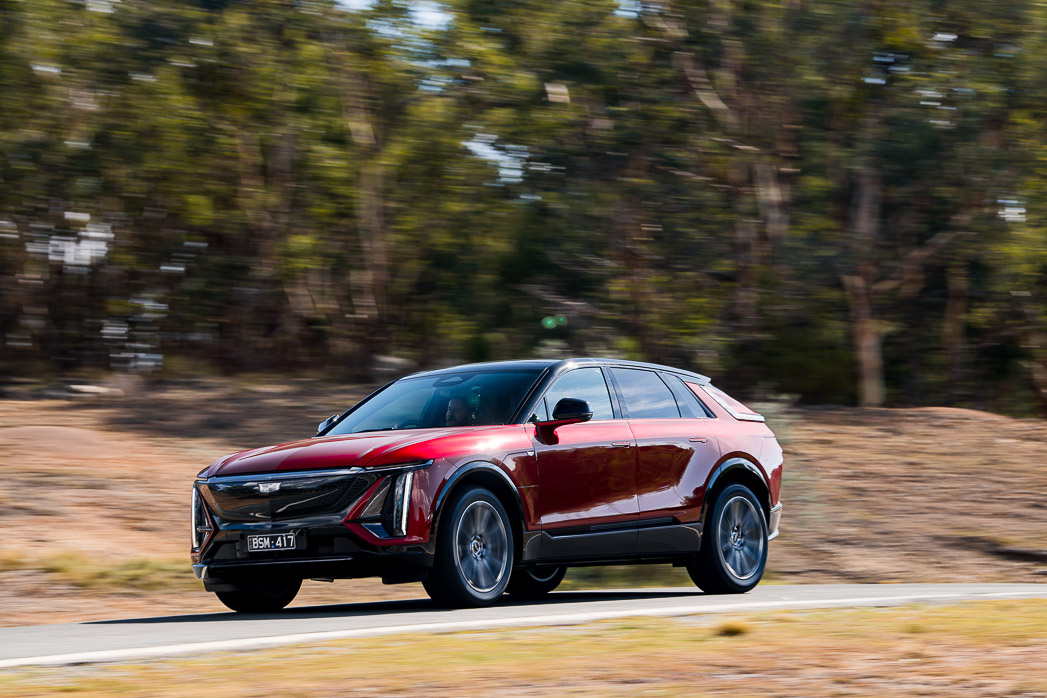
The Lyriq’s ride is reasonably supple, offering a degree of plushness at low speeds but much less absorbency over medium-sized bumps. It lolls around a bit too, and doesn’t offer the levelness you might expect, or any tangible sense of waft.
It’s not uncomfortable but it isn’t luxurious either – highlighting the unfortunate disparity between the supreme effortlessness of the Lyriq’s powertrain and the comparatively heavy and unresolved dynamics.
The nicely modulated, three-setting regenerative braking with full one-pedal operation is impressively refined in all driving situations, however the Lyriq remains a car that works best on a straight, smooth road.
There was a time when Cadillac interiors were truly special – before the cost-cutting of the 1970s started to undermine the brand’s luxury mystique.
Yet even the CTS sedans we drove in 2008 – prior to the brand’s aborted launch back then – were impressively well put-together for their time, with subtly luxurious design cues and good-quality materials.
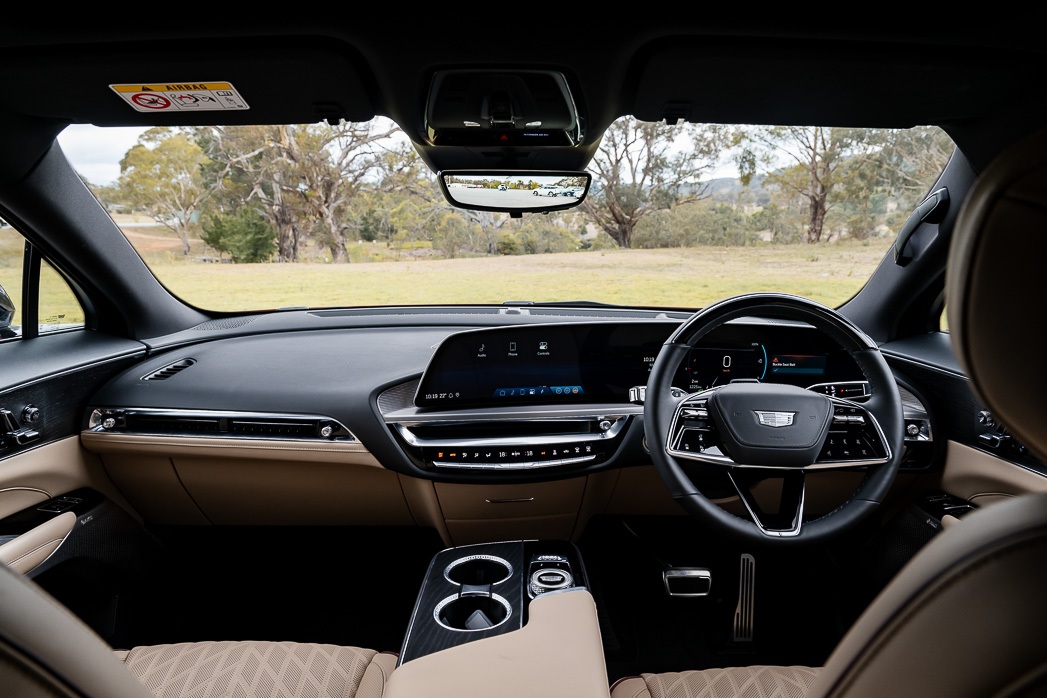
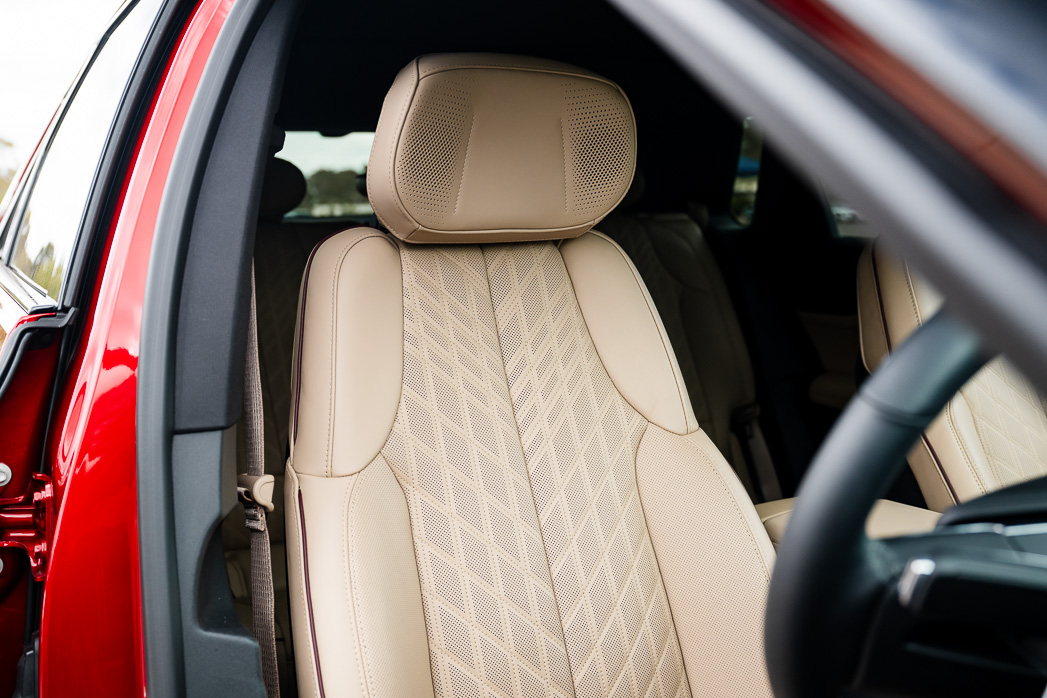
Seventeen years later, the Lyriq lives in a different time – one often defined by huge screens, gaudy lighting and flashy embellishments. And, unfortunately, it falls victim to all these trends, offering a mis-matching blend of textures and finishes that doesn’t convey expense.
Its maker boasts about the “specific Cadillac knurling etched on all components [and] the use of intricate back-lit laser etched patterns in interior décor design” but it results in a clash of patterns and eras that sits uncomfortably.
Of far greater concern, however, is the quality of the components in the Lyriq’s interior – compounded by an excess of cheap plasti-chrome and a lack of tactility in its switchgear.
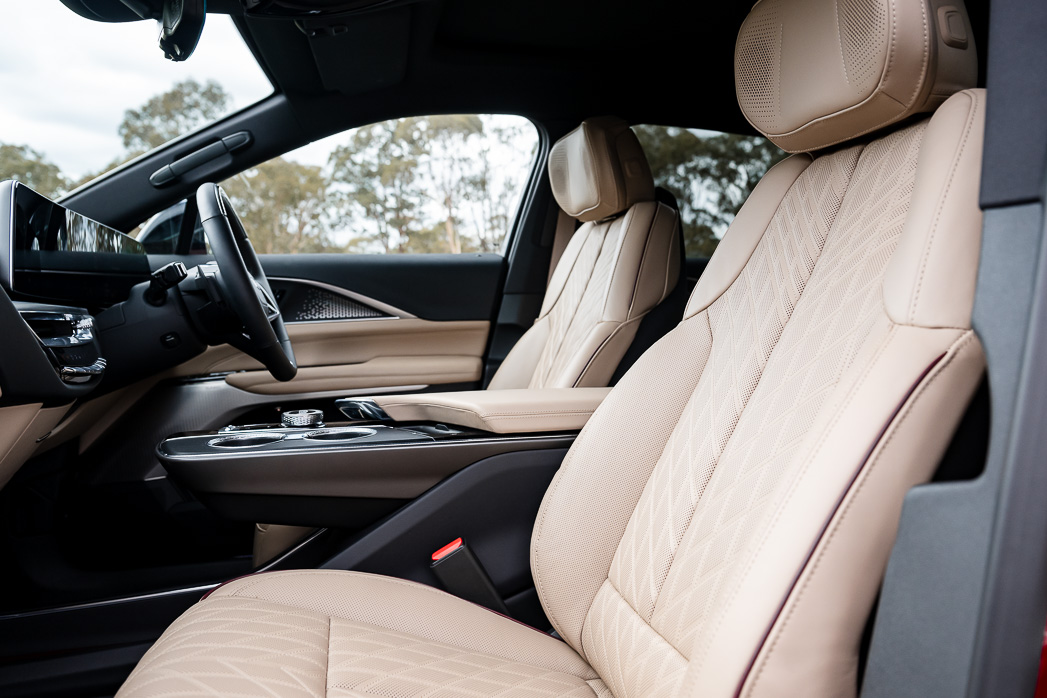
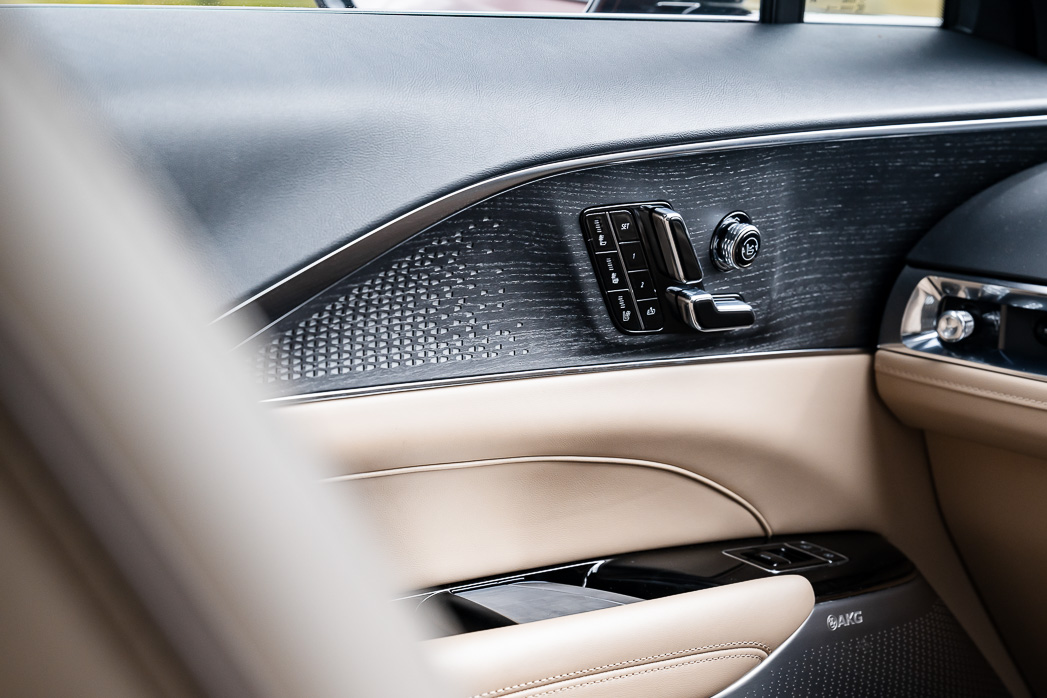
Chief offenders are the gritty-feeling door handles, the clumsy column stalks, the flimsy console-mounted control dial, the reflective plastic surrounding the difficult-to-modulate air vents, and the red-flock-lined centre dash tray that can be flexed up and down alarmingly.
But there’s also the tinny and ugly metal bar separating the dual-pane sunroof, the exterior charging flap that always shudders open, and the appalling quality of the vinyl luggage cover (for the otherwise-impressive cargo area) that would seem cheap in a Kia Picanto.
There’s more. The creaking of the Lyriq’s interior materials when the car is cornering is conspicuous, as is the considerable door trim/dash fascia misalignment in one of the test cars.
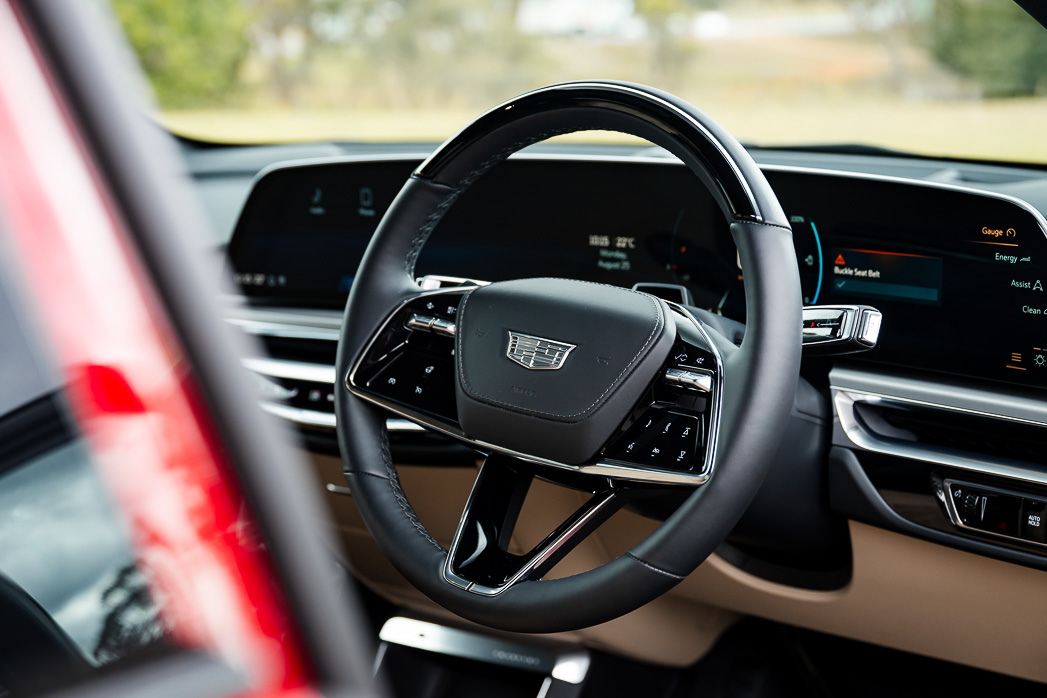
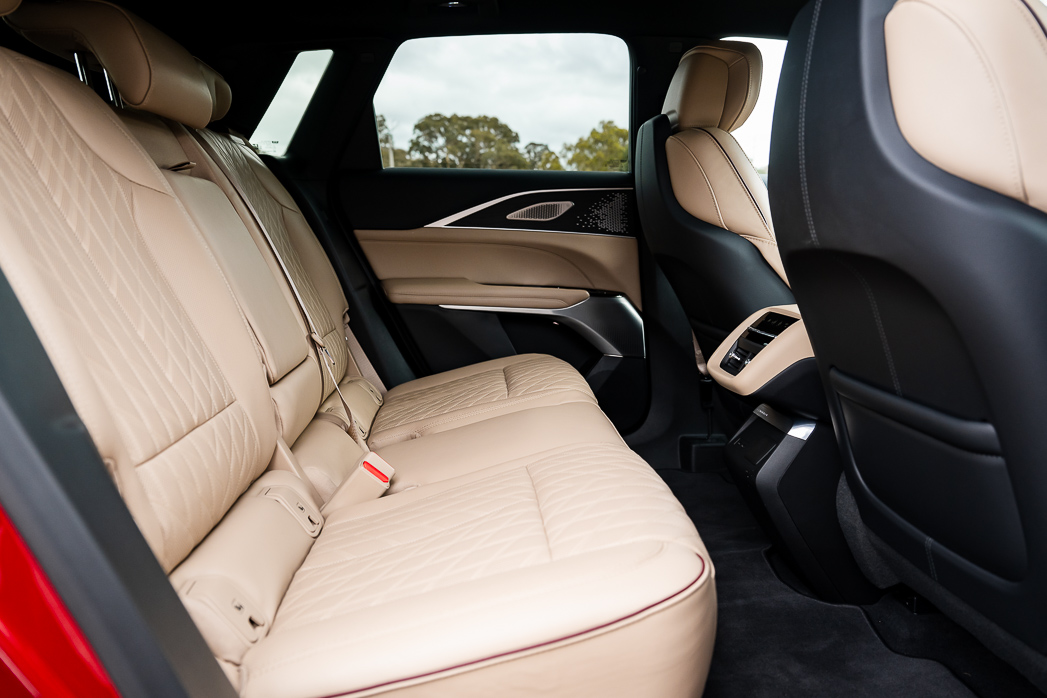
Then there’s the seating. The Sport’s optional Oxford Stone light-brown perforated leather is delightful – an upscale upholstery choice arguably eclipsed by the Juniper Green Nappa leather option, seeing it also colour-codes the dashboard and door tops (rather than leaving them black).
But in both cases, Nappa leather replaces ‘Inteluxe’ (in light grey or black) – a luxuriously named vinyl that doesn’t feel particularly supple or expensive. And there’s inadequate bolstering for the front seats, meaning you slide around in corners, holding onto those thick wheel spokes for purchase (or accidentally grasping the wheel rim’s crap plastic insert).
But it’s the rear seat that is really the mic-drop moment for this Cadillac – it’s not good. The cushion is short and flat, leaving occupants sitting splay-legged, and there’s a panel inserted between the cushion and backrests to house the Isofix mounting points that acts like a ridge and juts into your butt. Talk about wasting all that airiness and legroom!
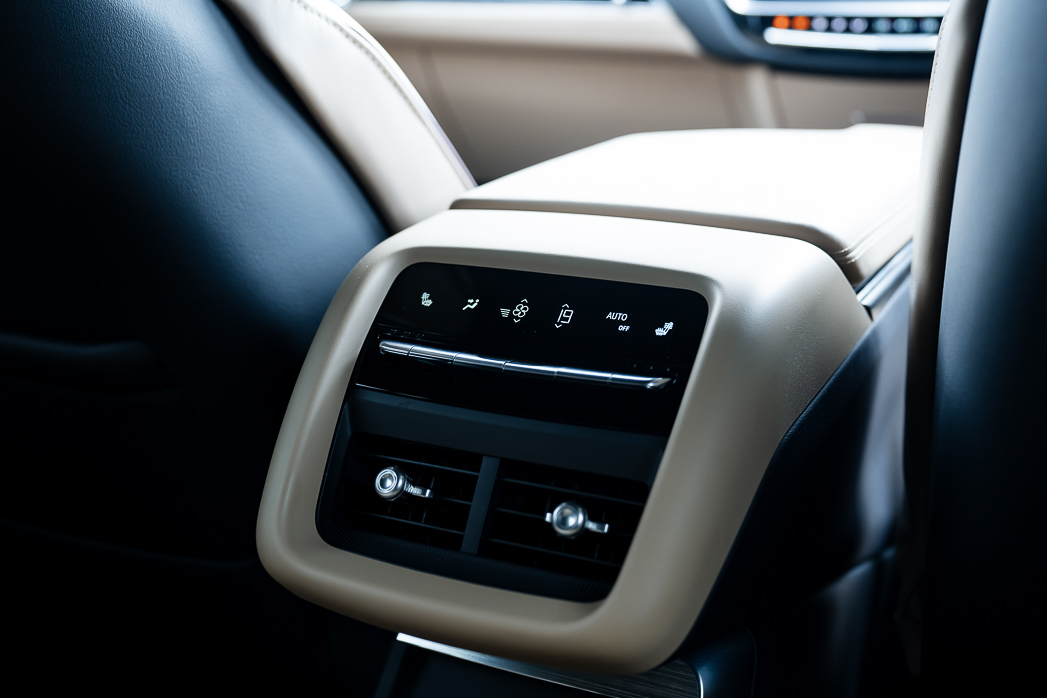
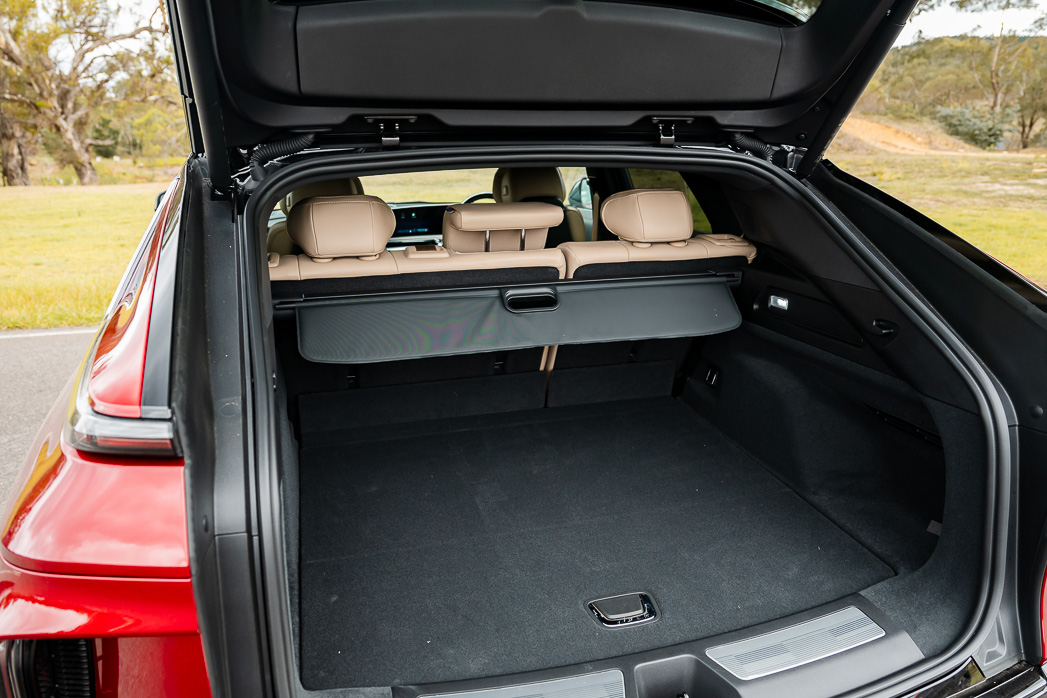
There’s also evidence of expedient right-hook conversion such as the blank panel over the rear power outlet (instead of engineering a three-prong Australian version) and, worse, the front A-pillar grab handle that’s been added to help passengers climb in remains in its left-hook position, making it redundant, while it also blocks the driver’s vision.
Even the Apple CarPlay doesn’t fill the space in the curved dash screen, though the Art Deco styling of the metallic AKG door speakers (adding yet another texture!) is gorgeous, and the 19-speaker audio quality is deserving of a car attempting to convey a suggestion of grandeur.
The Cadillac Lyriq hasn’t been independently crash tested by any global NCAP organisation, however it has been tested by the IIHS (Insurance Institute for Highway Safety) in the US and received the highest ‘Good’ rating across the board – apart from its headlight performance (Poor) and its forward AEB for pedestrian protection (Acceptable).
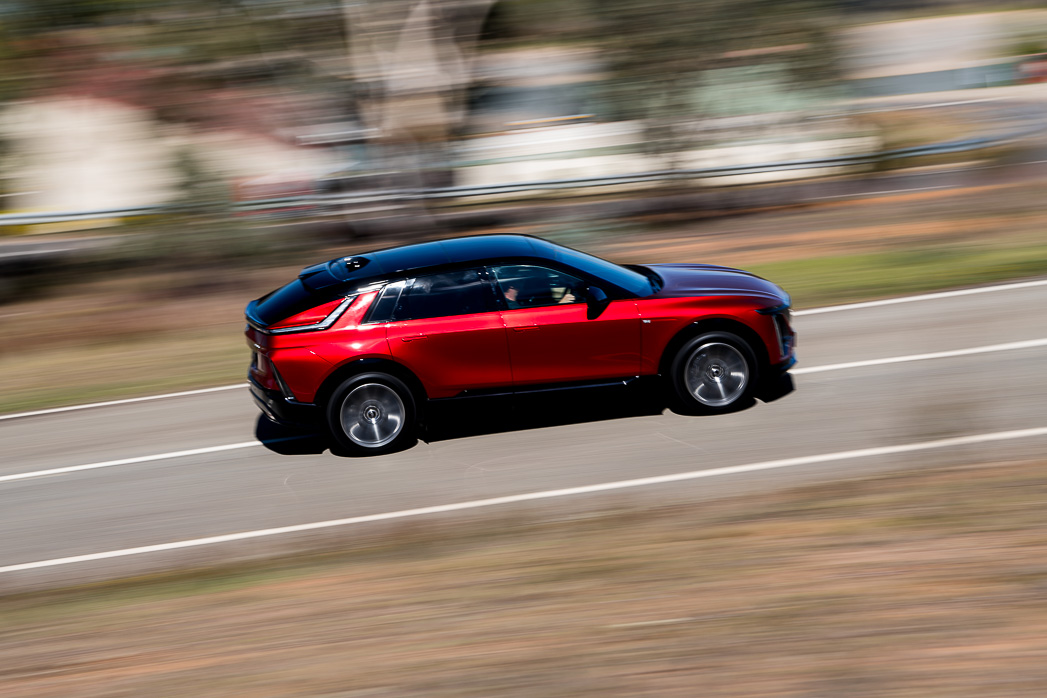
Standard safety equipment on the 2025 Cadillac Lyriq includes:
For the most part, the Lyriq’s active-safety systems work effectively, though having the driver’s seat cushion vibrate gratuitously as a lane-departure warning, blind-spot alert or driver attention warning takes getting used to. It also reeks of the discontinued (Mexican-built) Holden Equinox, featuring the same system, which isn’t a flattering comparison.
The Lyriq also produced two unnecessary AEB moments during a regular urban commute, where it became spooked in two environments that have rarely troubled any other test car.
The official WLTP range figure for the dual-motor Cadillac Lyriq is 530km. Using a DC ultra-fast charger, the Lyriq’s 10 to 80 percent charging time is 27 minutes, with a maximum DC rate of 190kW.
In comparison, the WLTP range claims of the Lyriq’s chief competitors include the Audi Q6 e-tron quattro (540km), Polestar 3 Long Range AWD (610km) and recently facelifted BMW iX xDrive 45 (522km).
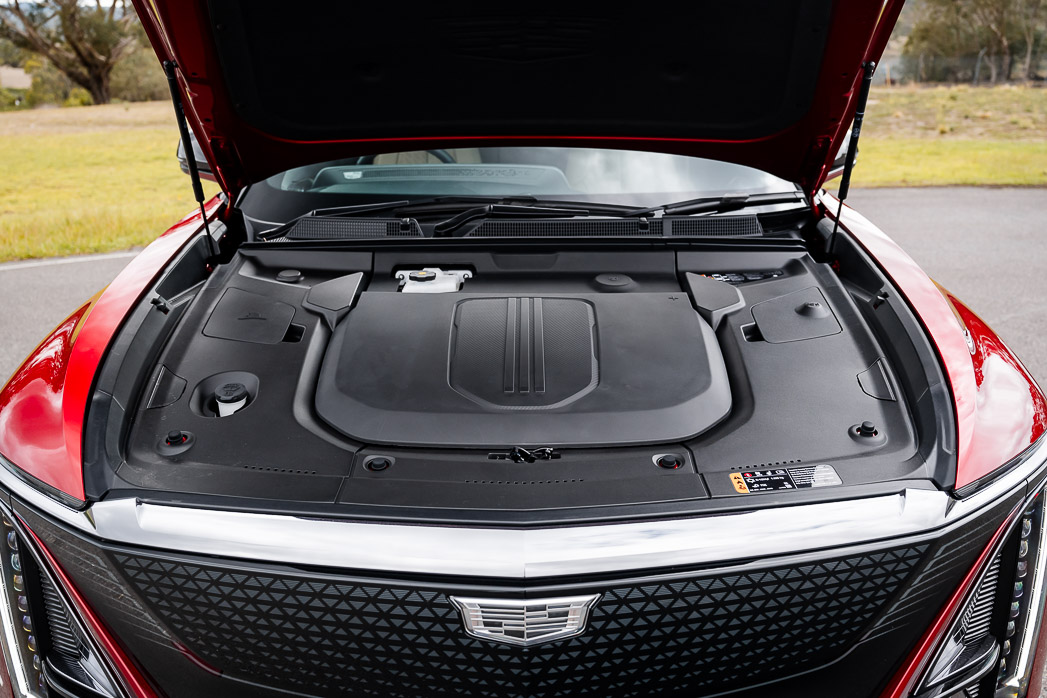
Using a wall-mounted AC home charger, the Lyriq can be fully charged in 16h 15min using a single-phase 7.4kW charger. On a 22kW three-phase charger, the Lyriq can be fully charged in 5h 30min.
Recommended service intervals are every 12 months or 12,000km, with the cost of the first five scheduled services being included with the vehicle purchase. Cadillac’s new-vehicle warranty in Australia is five years/unlimited kilometres, combined with five years of roadside assistance.
We really wanted to like the Lyriq – especially given that we’ve waited so long for a Cadillac to be officially sold in our market again.
On paper, it appears to offer plenty of distinctive metal for the money and GM in the US has developed a solid reputation for driving appeal and design chic in recent years. As the debut electric Cadillac and the debut vehicle on GM’s latest BEV3 electric platform, the Lyriq certainly has the potential to make an impact.
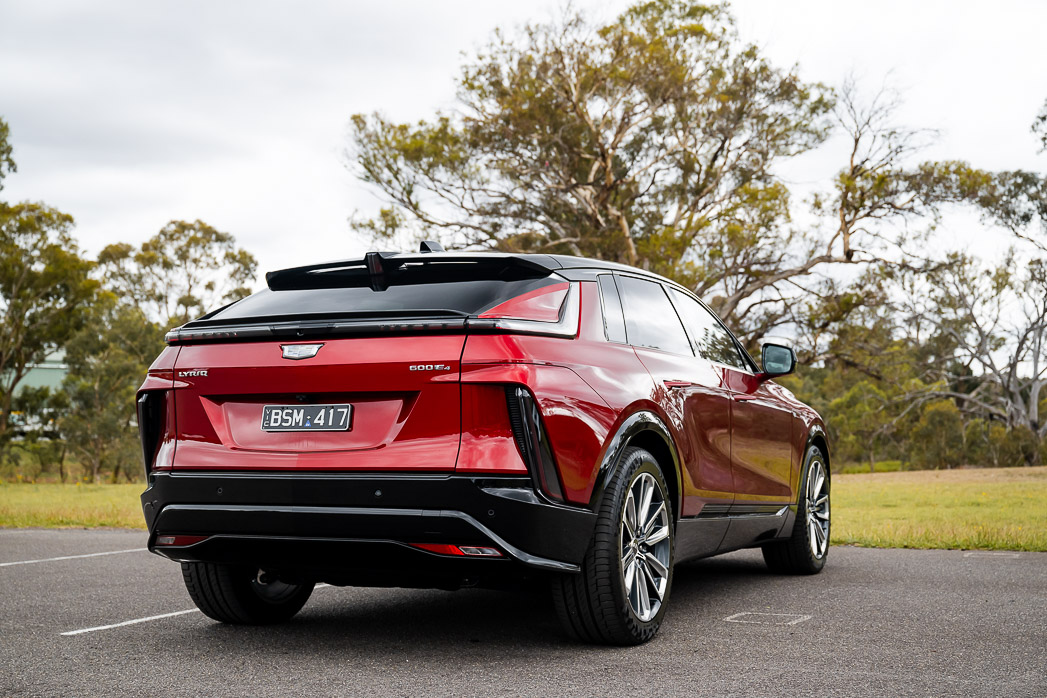
But in practice, it fails. Despite its individual styling and level of equipment, the Lyriq fumbles in too many areas to feel sophisticated, let alone armed with the excellence to confidently reintroduce the Cadillac brand to an extremely competitive and mature market like Australia.
Its interior design looks and feels clumsily inexpensive in many areas, its seating comfort is inadequate, and the quality of materials is well below expectation, to the point where some things don’t feel robust.
Even if the Lyriq were a Holden Calais, we’d be highly critical of its flaws. But that GM product went out of production eight years ago, commanded half the Lyriq’s asking price and suffered from none of these failings.
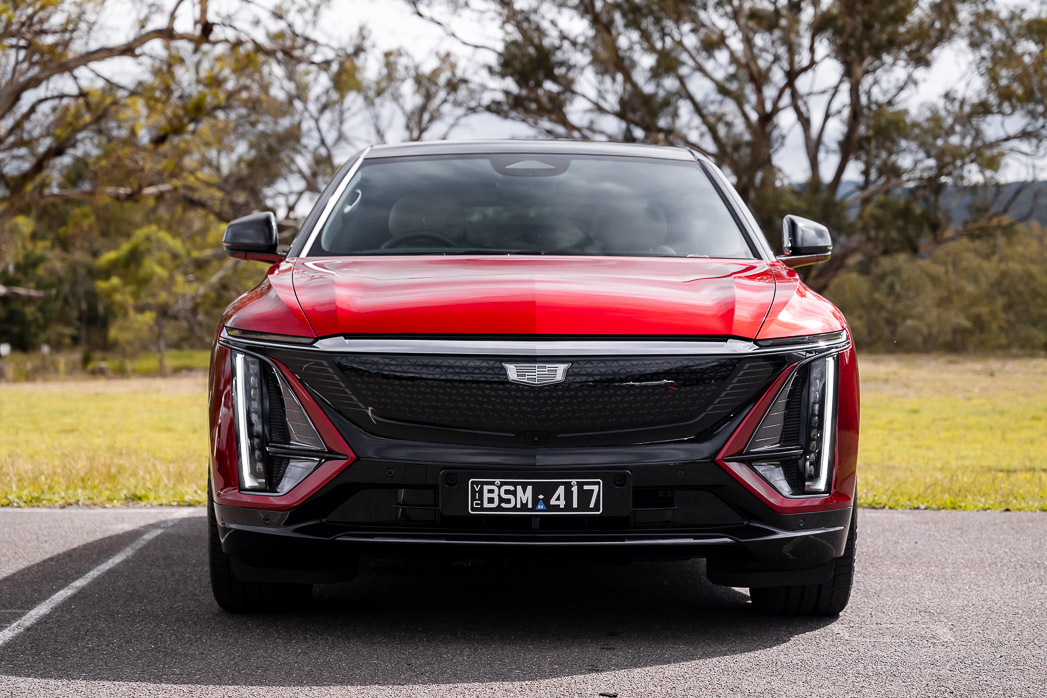
Globally, GM’s decision to launch (or re-launch) in right-hand-drive markets with the electric Lyriq – as well as penetrate Europe – makes some sense given the progression towards electrification. In terms of its electric powertrain, the Lyriq is terrific.
But here we are, three years since Lyriq production began, and no attention appears to have been paid to ironing out the Lyriq’s flaws for global consumption – not to any discernible degree.
Perhaps the forthcoming smaller Optiq electric SUV and larger seven-seat Vistiq electric SUV – both set to be manufactured in right-hand drive – can make amends here, but we’ll have to wait until 2026 to find out. Or possibly the significantly uprated, hi-po Lyriq-V if it makes its way Down Under.
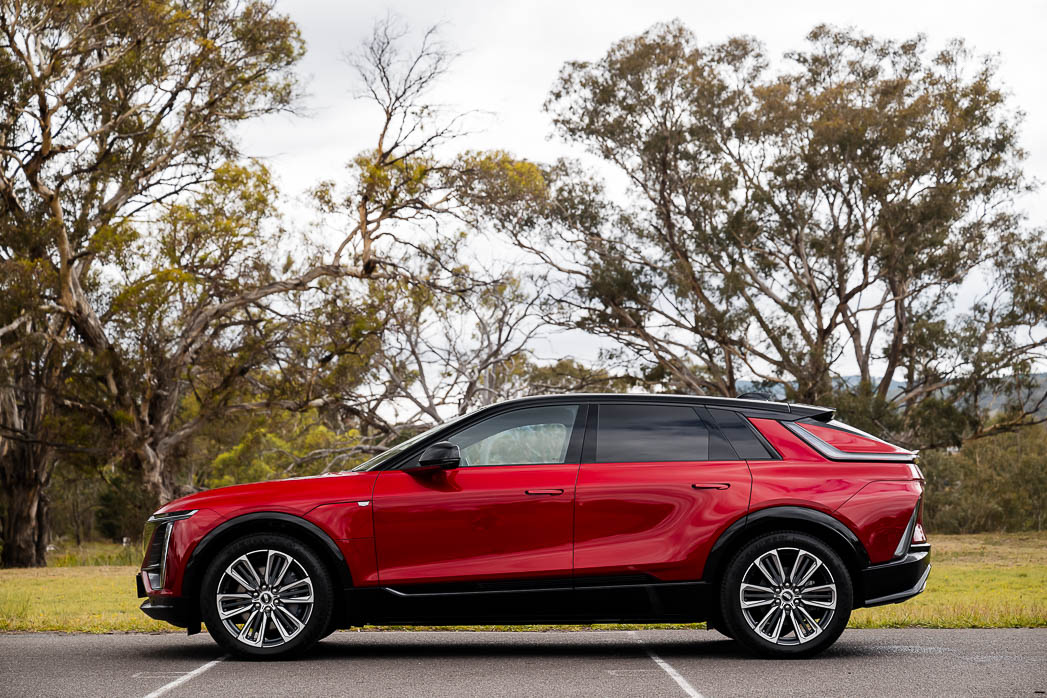
From an Australian perspective, the ideal vehicles to launch Cadillac in our market would’ve been the supercharged V8 CT5-V Blackwing and twin-turbo V6 CT4-V Blackwing, or even the regular CT5-V and CT4-V sedans – each filling a niche vacated by General Motors in 2017. Sadly, none of those Cadillacs are produced in right-hand drive.
Instead, we have the half-baked Lyriq, which simply isn’t good enough – not when it’s being compared to the all-pervading slickness of its finest European rivals, in a country far removed from the North American freeways that this Cadillac was intended to inhabit.
[Editor’s note: Pricing for Lyriq was raised by $5000 just prior to the publication of this review. The Luxury now lists for $122,000 and the Sport is priced at $124,000, both before on-road costs.]
Key specs (as tested)
About Chasing cars
Chasing Cars reviews are 100% independent.
Because we are powered by Budget Direct Insurance, we don’t receive advertising or sales revenue from car manufacturers.
We’re truly independent – giving you Australia’s best car reviews.
The estimate provided does not take into account your personal circumstances but is intended to give a general indication of the cost of insurance, in order to obtain a complete quote, please visit www.budgetdirect.com.au. Estimate includes 15%^ online discount.
^Conditions Apply
Budget Direct Insurance arranged by Auto & General Services Pty Ltd ACN 003 617 909(AGS) AFSL 241 411, for and on behalf of the insurer, Auto & General Insurance Company Limited(ABN 42 111 586 353, AFSL 285 571).Because we don’t know your financial needs, we can’t advise you if this insurance will suit you. You should consider your needs and the Product Disclosure Statement before making a decision to buy insurance. Terms and conditions apply.
Indicative quote based on assumptions including postcode , 40 year old male with no offences, licence suspensions or claims in the last 5 years, a NCD Rating 1 and no younger drivers listed. White car, driven up to 10,000kms a year, unfinanced, with no modifications, factory options and/or non-standard accessories, private use only and garaged at night.
^Online Discounts Terms & Conditions
1. Discounts apply to the premium paid for a new Budget Direct Gold Comprehensive Car Insurance, Third Party Property Only or Third Party Property, Fire & Theft Insurance policy initiated online on or after 29 March 2017. Discounts do not apply to optional Roadside Assistance.
2. Discounts do not apply to any renewal offer of insurance.
3. Discounts only apply to the insurance portion of the premium. Discounts are applied before government charges, taxes, levies and fees, including instalment processing fees (as applicable). The full extent of discounts may therefore be impacted.
4. We reserve the right to change the offer without notice.